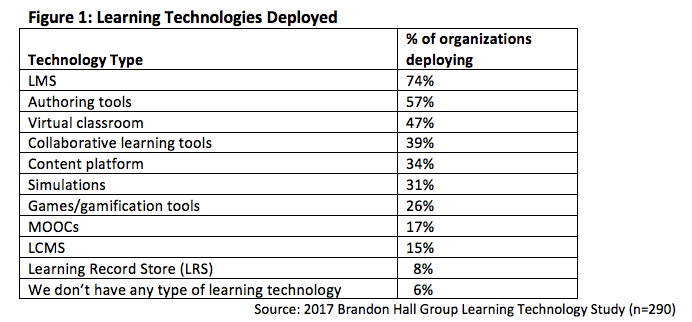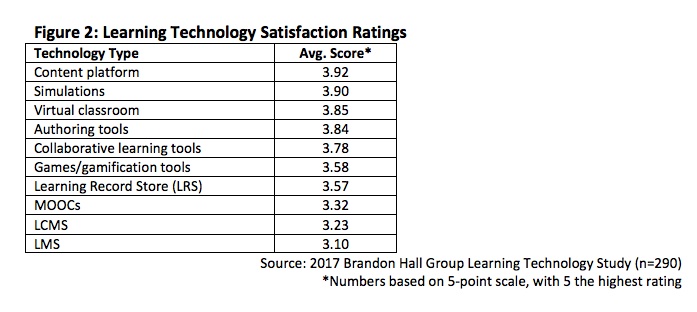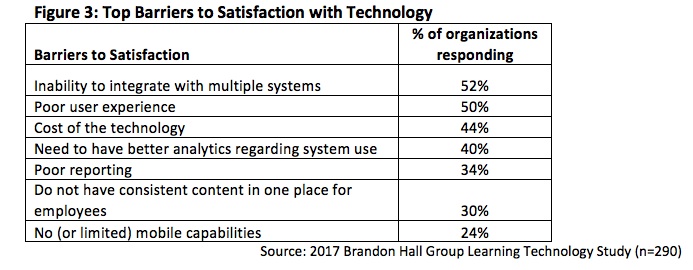
In a relatively short period of time, the learning technology landscape has exploded from a set of well-defined tools, such as a learning management system (LMS) or authoring tools, to a vast array of solutions aimed at delivering a variety of learning experiences and content across a spectrum of devices and media.
Organizations used to have one line item in the budget for technology, but today there potentially could be dozens of different platforms being deployed at once.
The complexity of the technology landscape means that organizations need to be highly prepared to navigate if they want to be sure they are deploying the right solutions to execute on their learning strategy. Unfortunately, nearly two-thirds of companies have either a poorly defined technology strategy, or—worse—no strategy at all, according to Brandon Hall Group’s 2017 Learning Technology Study.
Only about one-third of the companies have a mature strategy for their technology and have integrated it with other systems, according to the research. And while these companies are better positioned to take advantage of their available technology, even fewer (12 percent) have the data analysis in place to draw sound conclusions about learning’s impact on the business. And while large companies (10,000-plus employees) are more likely to have technology in place, the maturity levels remain about the same, with only 15 percent (compared with 12 percent overall) at what we call an “optimized” learning technology maturity level.
Given that more learning solutions are going to be deployed in concert with one another, a strategy that centers around integration is critical. Measuring the impact these tools have on learning and the business is much more challenging if a company isn’t even sure how they all work together.
Here are three key findings from the learning technology research that may provide insight into how to get the most out of your learning technology.
The Learning Technology Landscape Will Grow More Complex
In the not too distant past, companies only had to concern themselves with one type of learning technology—the LMS. In past Brandon Hall Group studies, we consistently found that approximately 85 percent of companies had deployed an LMS. Now, with such a wide variety of technologies available—some that work with an LMS and some that supplant it—we’ve seen that number drop to less than 75 percent.

The LMS is still the most commonly used solution by a wide margin, but we see growing adoption of many other tools. For example, more than one-third of companies use a content platform, a solution that provides an interface on top of a content library. Nearly 40 percent use collaborative learning tools that connect learners to one another, through media sharing, discussions, and more. Also significant is the adoption of simulations and gamification tools. For the most part, these tools are being used in conjunction with an LMS, which only highlights the necessity of a good technology strategy to make sure all of these tools are working together to serve the same purpose.
And it only looks to get more complicated for most companies as two-thirds plan to acquire new learning technology in the next 12 months. That means they must figure out how to roll out, integrate, and assimilate yet more learning technology—and soon.
User Experience and Integration are Critical
Quite often in our research, we report dismal satisfaction rates with technology across the entire human capital management (HCM) spectrum. In 2015, not one aspect of LMS satisfaction scored higher than 3.5 on a 5-point scale. In fact, the average satisfaction rating across 17 LMS features was 2.96 (the equivalent of 59 out 100—an F). As seen in Figure 2 below, the LMS scores slightly better overall in 2017, but lags behind every other type of learning technology.

The bottom-of-the barrel satisfaction rating indicates the frustration that organizations feel with traditional LMS platforms as they try to create and deliver more modern learning experiences. Companies are much more satisfied with newer technologies such as content platforms and simulations. Even games and Massive Open Online Courses (MOOCs) score better than the LMS, and these are platforms companies have been challenged to adopt.
User experience has perennially been the biggest challenge with learning technology. Companies regularly complain that the platforms are not easy to use, not intuitive, and do not have a modern look and feel. Those complaints traditionally have been lodged against LMS solutions, though, and more modern tools have been designed with the end-user experience more front of mind.
In the 2017 study, integration has supplanted user experience as the biggest challenge. This solidifies our findings that a strong technology strategy is required to integrate all of these learning solutions with each other and other systems throughout the business.

In fact, when we look at the competencies companies say are important for technology providers to possess, 85 percent say integration capabilities are either essential or critical.
A Solid Selection Process is Critical to Success
When organizations do give their learning technology poor satisfaction ratings, it usually can be tied back the original selection process. Technologies that are chosen solely to solve immediate problems typically end up with shortcomings in the long run. Fewer than half of companies believe their learning technology selection process is effective.

Nearly one-quarter of companies say their process is outright ineffective, which highlights how much impact the process can have on satisfaction. To try and understand what leads to effectiveness, we looked at some differences between companies with effective selection processes and those without.
One-quarter of companies reporting a neutral, somewhat ineffective, or very ineffective process said they had no formal technology selection team. For those that said somewhat or very ineffective, that number is 40 percent. The correlation becomes clear, then, that those companies without a formal selection team are 60 percent more likely to report an ineffective selection process.
There are organizations, however, that have a team, yet still report dissatisfaction with the process. This could be due in part to who is on the team. These companies typically had representatives from Learning, IT, and HR on the team, but few had people from other parts of the business. For those companies with an effective process, Learning, IT, and HR were still the most likely representatives, but we also saw more representation from business stakeholders and areas such as sales, finance, and the technology users themselves.
Probably most telling about the selection process are the lessons learned by organizations with an effective process and those without. The study asked what they would change about their most recent selection process. The top actions the entire survey population wished it had done differently was “develop a change management plan,” and “budget more time for implementation.”
Takeaways
- Learning technology success is tied inextricably to strategy and planning. There is a clear correlation between satisfaction with technology and processes and having a robust strategy in place.
- Focus on learners and the experience they will have using the technology. All the features, functionality, and administrative capabilities in the world will not save a platform users believe is out of date, hard to navigate, or simply difficult to use.
David Wentworth is Principal Learning Analyst for Brandon Hall Group, the largest independent research/analyst firm in the Human Capital Management market. The firm’s vision is to inspire a better workplace experience, and its mission is to empower excellence in organizations around the world through its research and tools. Brandon Hall Group has five HCM practices and produces the Brandon Hall Group Excellence Awards and the annual HCM Excellence Conference, held Jan. 30-Feb. 2, 2018, in Palm Beach Gardens, FL.




